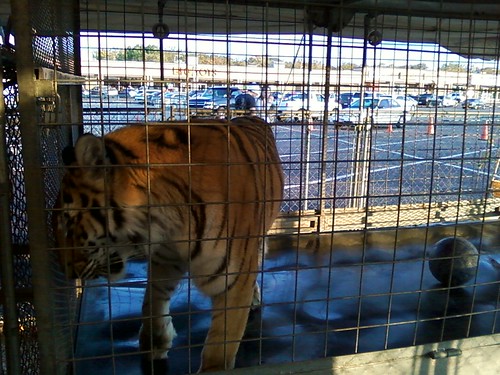It is amazing that only animals in captivity display repeated or stereotypical behaviour - and not animals in the wild. Repeating the same actions again and again is something that is thought to characterise a very high percentage of behaviour found in animals living in laboratory conditions (more than 50% by some stats). Types of behaviour consists of:
- wool chewing in sheep, where sheep in close proximity chew the wool of the sheep in front
- steel bar chewing in pigs and cows where enclosures are very small and diet is restricted
- cage jumping in mice
- cage pacing where physical space is very limited e.g mink, zoo animals etc.
Many factors have been given in trying to understand these events. But the concept of thwarting is key. Animals fed on artifical diets (e.g. liquid diets) may never get to experience a 'gut full' feeling, so they remain in feeding mode constantly. This may spill over onto objects that are not food related e.g. steel bars. In fact diet is very important in how an animal regulates its behaviour because food seeking or oral behaviours are linked to internal assessments by the organism of its energy and nutrient requirements. Pacing is another common behaviour, especially in animals that have evolved to roam long distances. Big cats or dogs in pent up conditions will often display this. Again being prevented from fulfilling natural behaviour patterns means these patterns emerge in ways that betray a stereotypical quality. Cage jumping in mice is also very common, though some view it less as a displacement behaviour (a behaviour that is expressed because another regular behaviour has been thwarted by the environment) as a direct response to wanting to escape from confinement.
Understanding human behaviour in terms of captivity is more difficult. Humans are rarely kept in cages, except in prisons, and even then it can be argued that man is an adaptive animal with the intellectual ability to understand and regulate his situation. On the other hand, some people might suggest that all of human life is a form of captivity in as as far as we all have to accept limitations on our natural desires for much of the time. The point at which everyday repression tips towards producing stereotypical behaviour is what interests me a lot.
The tipping point seem to be when the environmental possibilities or opportunities for self expression and self-regulation become so restricted that a person is no longer is able to exercise control over his/her state of being. For example, hair pulling has been found in children who exist in a symbiotic relationship to their parents. This may mean the parent is so controlling that the child can only express its needs and desires through the agency of the parent figure and has no independent power. Every need or want must be negotiated via the parent e.g. approval sought, permission granted, compromises made. This power imbalance and over-dependence means that the child has little chance of regulating its own internal state. Hair pulling has also been found in those children where incest has occurred. Inability to avoid incest (or the sexual behaviour of parents), itself a very important aspect in ensuring genetic health of offspring, means that something very fundamental has been violated. In short, the capacity to control homeostasis - the ongoing relationship between internal state and environment is compromised. This lack of control or self-sovereignty, in the absence of bars, constitutes a mode of captivity. For what is captivity if it is not the freedom to fulfill one's own needs and determine one's own inner sense of emotional well-being? This is a major starting point for people seeking to better understand self-directed behaviours in humans in my view.

No comments:
Post a Comment
Please leave your comment below: